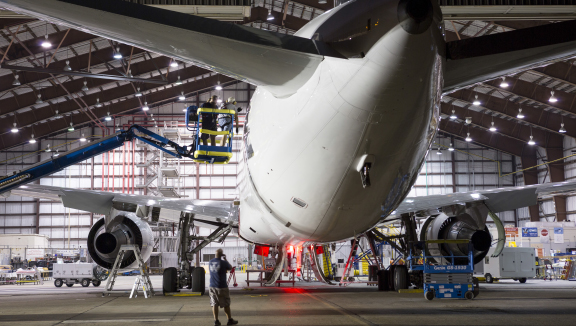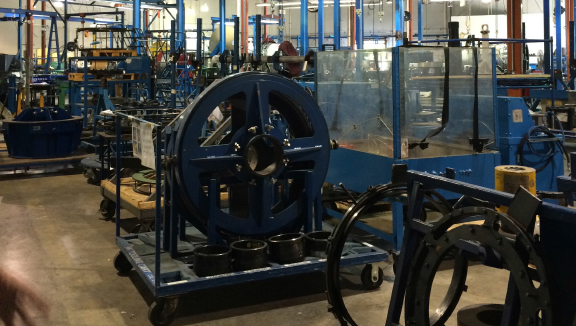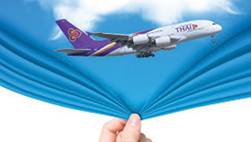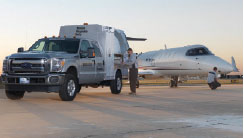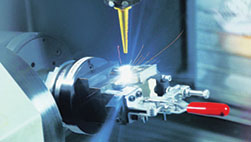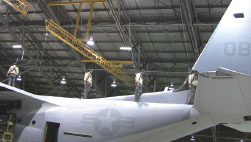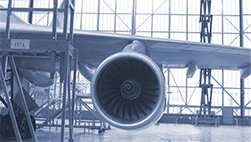Low fuel prices and anticipated higher interest rates will spur MRO growth over the long term by allowing middle-aged and mature aircraft to fly longer, producing more maintenance, repair, and overhaul business for their engines, components, and airframes.
Low fuel prices have made it more attractive to fly older aircraft longer,” says Bill Dwyer, general manager, services marketing, for GE Aviation. “Industry-wide, retirements are down more than 50 percent, compared to 2013,” he says, and “most analysts predict a period of sustained low fuel prices.” He also points to the expected rise in borrowing costs, which tend to favor used aircraft. “We think these factors will continue to spur interest in extending in-service life, and that creates opportunity for everyone in the MRO space.”
Major Trends
ICF International expects the global air transport MRO market to expand from $62.1 billion in 2014 to $90 billion in 2024, or about a 3.8 percent compound annual growth rate, with Asia-Pacific and China as the drivers. China and Asia-Pacific, combined, are expected to spend more than $29 billion in 2024, compared with $16.9 billion in 2014. MRO firms will continue to expand their footprint in this area.
Meanwhile, U.S. carrier wide bodies are coming back to North America, analysts note. This reflects factors such as increasing labor rates in Asia, currency valuations, and the sophistication of U.S. carriers’ analysis of the total costs involved in outsourcing, says Jonathan Berger, vice president of ICF International.
Relatively lower costs in the U.S. as a result of changes in the dollar are important in this shift, but so is really good technology, says Wayne Plucker, director of aerospace research for Frost & Sullivan. He cites AAR, the U.S. MRO. “They understand composites [and] can work with more sophisticated engine materials, [which] tends to reshore some of that [work].” AAR also has invested in IT, allowing customers, for example, to access their asset data in real time.
A lot of North American carriers’ MRO is still done in Asia because a lot of those airlines fly there, Berger says. A key driver is, as Asian fleets continue their exponential growth, U.S. carriers will have to compete with increased organic demand for slots in Asia.
Other pressures continue to reshape the industry. There are still too many players in airframe and component maintenance, observers say, and this may drive further consolidation. In the component area airlines increasingly want MROs to provide a wide range of services at a predictable cost. Though the march of the engine makers into the aftermarket may have reached its peak, component OEMs continue to capture business, and MROs, especially the independent operators, are teaming with them.
Meanwhile the parting out of retired aircraft for reusable airframe, engine material, and components is a growing activity at major airlines, Berger says. AFI KLM Engineering & Maintenance (AFI KLM E&M) stresses its U.S. engine teardown capability through its joint venture (JV), Bonus Tech. The MRO sees growth in aircraft and engine teardown and associated parts trading services.
Delta Air Lines also has become a savvy player in the used parts arena to reduce the cost of maintaining its own mature fleet. In 2013 the carrier bought 23 MD-80s from SAS AB of Sweden. And Lufthansa Technik (LHT) in past years has purchased former Lufthansa aircraft and parted out components for internal consumption.
This trend means these airlines are buying fewer of these parts from OEMs and surplus traders and can sell excess supplies through surplus sales departments, Berger notes. The practice is pressuring the OEMs, who are now forced to find innovative ways to replace this revenue. Airlines continue to seek creative ways to reduce their operating costs, and finding alternate sources of material is a key strategic lever, he says. “It’s a really big change in the last two years.”
The top dog of the independent MROs is probably ST Engineering, the parent of ST Aerospace, Plucker says. “They don’t miss a chunk of the market,” including engines, airframe, and components. Berger places ST Aerospace with AAR and HAECO as the largest independent MROs.
The Singapore company invests in the U.S. as well. In addition to existing sites there, it plans to open a facility in Pensacola, Fla., late next year and has opened a new parting-out business in Hondo, Texas.
AAR
AAR is the largest independent MRO in North America and the third-largest airframe MRO in the world in terms of man-hours and revenues. In 2014 AAR performed about 5 million man-hours of airframe maintenance and expects to do about the same this year, says Dany Kleiman, group vice president for repair and engineering. Man-hours are up from 3 million only three to four years ago.
The company as a whole recorded net sales of $2.04 billion in FY2014, down from $2.14 billion the year before, according to its annual report. But AAR’s MRO revenues grew in 2014 and will continue to grow, Kleiman says. In 2014 AAR serviced 900 to 1,000 aircraft, mostly U.S.-registered commercial carriers.
The company has been expanding wide body capacity in the last two years, taking a lease on a facility in Lake Charles, La., and building a new facility in Rockford, Ill., which is expected to open next year. “We see that U.S. companies are more competitive today with Asia-Pacific providers, and we are looking forward to the in-shoring, instead of out-shoring, of services to U.S. carriers,” Kleiman says.
Component MRO
While ST Aerospace expects engine MRO to drive market growth, it anticipates that component MRO growth will catch up with the engine sector in the next five years. ST Aero’s maintenance by the hour (MBH) program supports nearly 900 aircraft and more than 20 operators with fleets in Asia-Pacific, Europe, and the Middle East.
AFI KLM E&M is a major player in CMRO. As far as multiproduct MRO is concerned, AFI KLM E&M ranks No.1 or No. 2 for component support, depending on the fleets, says Rob Pruim, vice president, strategy, for the business. The component MRO market is robust and growing, he says. “There is widespread availability of spare parts for some aircraft types like the A320 and A340.”
The Franco-Dutch maintenance business sees component MRO, along with engine MRO, as a path to growth. AFI KLM E&M signed a long-term contract with Royal Air Maroc in 2015 to support component repair and overhaul for 787s. It likewise inked a deal with Thai Airways International involving component support for 787s. The agreement includes support for consumables, rotables, and tooling and equipment, as well as for APUs and engine nacelles. In fact, AFI KLM E&M considers itself the current market leader for 787 component support.
